Overview
This lab is all about those “fit-and-finish” scenarios in Azure DevOps Server that will make developers more productive as they write code and collaborate with other team members. You’ll learn about integrated code reviews; the “My Work” experience for managing your active tasks; and once you’re “in the zone”, Visual Studio will now help you stay focused on the task at hand, no matter how much you’re randomized, with a suspend/resume experience. You’ll also learn how to work offline seamlessly, how the new merging experience works, and how you can more easily find work items.
Prerequisites
In order to complete this lab you will need the Azure DevOps Server 2019 virtual machine provided by Microsoft. Click the button below to launch the virtual machine on the Microsoft Hands-on-Labs portal.
Alternatively, you can download the virtual machine from here.
About the Fabrikam Fiber Scenario
This set of hands-on-labs uses a fictional company, Fabrikam Fiber, as a backdrop to the scenarios you are learning about. Fabrikam Fiber provides cable television and related services to the United States. They are growing rapidly and have embraced Windows Azure to scale their customer-facing web site directly to end-users to allow them to self-service tickets and track technicians. They also use an on-premises ASP.NET MVC application for their customer service representatives to administer customer orders.
In this set of hands-on labs, you will take part in a number of scenarios that involve the development and testing team at Fabrikam Fiber. The team, which consists of 8-10 people has decided to use Visual Studio application lifecycle management tools to manage their source code, run their builds, test their web sites, and plan and track the project.
Exercise 1: Making Developers More Productive with Azure DevOps Server 2019
Task 1: Team Explorer Overview
In this exercise, you will see a high-level view of the changes made to Team Explorer in this release and learn how to navigate the functionality that is made available there. If you are new to Azure DevOps Server, you can think of Team Explorer as the primary way in which a Visual Studio user accesses Azure DevOps Server functionality.
-
Log in as Sachin Raj (VSALM\Sachin). All user passwords are P2ssw0rd.
-
Launch Visual Studio from the taskbar.
-
Open the FabrikamFiber project listed on the Start Page.
-
The Team Explorer window provides a central hub for common tasks that developers undertake when working on a project, including source control, work item tracking, collaboration features such as code review and team rooms, and even quick links to other resources found in the web portal such as task board.

-
Navigation within Team Explorer operates similarly to a typical web application in that you follow links from the home screen, and can navigate backwards and forwards or return home at any time. We will put this navigation to use in the next exercise, as well as drill into the various hubs and pages exposed within Team Explorer. When this lab refers to the Back or Home buttons, these are the ones.

-
Click Work Items.

-
The Work Items view shows favorite queries for the logged-in user and the team, as well as provides the capability to add new queries and work items.

-
Click the Home button.
-
Click Source Control Explorer. This provides a view into everything stored in source control, as well as its local status.


-
Click Settings to view the team project and team project collection options.


-
Click the Home button.
-
Click Builds to manage build definitions and view build history.


-
We will look at the new My Work functionality in the remaining exercises.
Task 2: My Work
-
In this exercise, you will learn about the new My Work experience for managing your active tasks.
-
Click the Home button.
-
In Team Explorer - Home, click My Work.

-
The My Work node shows work items in progress, available work items, and suspended and shelved work for the currently logged in user. This workflow uses a task-based development model to help keep team members in-sync with each other.

-
Click the Open Query hyperlink that is located in the Available Work Items section. This will open a new browser window to the query on Azure DevOps.

-
Select the Editor tab. You can review all of the details and flexibility available to customize any query.

-
Close the query browser window without saving changes.
-
Let’s say that we want to work on one of our available work items. On the My Work page in Team Explorer, right-click the item that starts with “Write code to get GPS location…” and choose the Add to In Progress option from the context menu. This communicates the current state of the work item to our team.


Task 3: Local Workspaces
-
In this exercise, you will learn about local workspaces and how they improve the offline development experience.
-
In Source Control Explorer, double-click on the FabrikamFiber.CallCenter.sln file in the Dev branch to open it.

-
Server-based workspaces used to be the only option available in Azure DevOps Server (prior to Team Foundation Server 2012). With server workspaces, source control operations are performed exclusively on the server, so working in a disconnected, offline scenario can be tedious. Local workspaces, which are now default, improve the development experience for smaller teams and projects. They provide a more client-centric workflow, a style of version control often described as Modify-Merge-Commit.
-
As an aside, server-based workspaces, which are better suited for larger projects, can certainly still be used if desired. Load the Manage Workspaces window by typing ‘workspaces’ into the Quick Launch search box in the top-right corner of Visual Studio and wait a second or two for the results to load. Select the Workspaces… command link.

Note: The Quick Launch search box can be used to find most of the settings, tools, and windows available in Visual Studio, no matter where they are found, saving you precious time clicking through menus. Use the Ctrl+Q key combination to avoid the mouse altogether.
-
In the Manage Workspaces window, click Add… to start creating a new workspace.

-
In the Add Workspace window, click Advanced to see all available options.

-
Locate the Location workspace property. By default, new workspaces will use local workspaces, but you can choose to create a server-based workspace if desired.

-
Close the workspace windows by pressing the Esc key twice.
-
In Solution Explorer, expand the FabrikamFiber.Web\Content folder.

-
Select fullcalendar.css to view its contents. Note that the file is loaded in the CSS Source Editor as expected, but the tab for it is shown on the right-hand side. This new tab type is called a preview tab - as you use the arrow keys to navigate between files or single-click on them, the preview tab will be replaced with the most recent selection. Preview tabs help address the problem where you can easily overwhelm your Visual Studio tab real estate with files that you only need temporarily.

Note: There is a button on the preview tab itself that allows you promote it to a regular tab (see the arrow in the screenshot above).
-
Make an arbitrary change to the fullcalendar.css file by changing one of the style properties. Visual Studio will indicate that the file has been checked out, but keep in mind that this has only been done in the local workspace. Other team members will not see that you are working on this file.

-
Two of the major benefits of the local workspaces are that the disconnected, offline work scenario is greatly improved, and it is much easier to use external tools to work with files in source control. To demonstrate both of these benefits in action, let’s proceed by stopping the Azure DevOps Server site in IIS. This will simulate a scenario where you are working offline, such as writing code from the beach. In a real-world scenario, you would never write code from the beach - you would be enjoying your vacation.
-
Launch Internet Information Services (IIS) Manager.
-
In IIS Manager, expand the VSALM server node and the Sites node to find and select the Azure DevOps Server site. Right-click it and select Manage Website | Stop.

-
Return to Visual Studio, load the Source Control Explorer window, and click the refresh button. Note that the window is now in a disconnected state. You may also get an error indicating the same, which you can dismiss.

-
Even though we are now in a disconnected state with Azure DevOps Server, we can continue to do work. Right-click the Content folder in Solution Explorer and select the Open Folder in File Explorer option.

-
Add a new file into the Content folder by right-clicking in a blank area of the view and selecting New | Text Document from the context menu. Accept the default name.
Note: We will use this file in a demonstration a little later - the contents are not important and can be left blank.

-
In the Explorer window, right-click Site.css and select Open With | Notepad from the context menu.
-
In Notepad, change the “body” style color to “red”.

-
In Notepad, save and close Site.css and return to Solution Explorer. Note that Visual Studio detected the change to the file and that the file was not read-only as it would have been in the case of a server-based workspace.

Task 4: Pending Changes
-
Click Home in Team Explorer, then click Pending Changes.

Note: You should see an error message in the Pending Changes window about being unable to connect to the remote server, but you can simply ignore it. We purposefully stopped Azure DevOps Server during the previous exercise.
-
In the Pending Changes window, we can see that the two changes made to existing files in the previous exercise automatically show up under the Included Changes section. Note that due to NuGet updates, you may see additional changes detected.

-
In the Excluded Changes section, there is a detected change that was not automatically marked as an included change. Note that there may be more adds detected due to NuGet references. Click the Detected link.

-
In the Promote Candidate Changes window, you can see the addition of the new text document. If there are additional items, uncheck all items using the header checkbox and then check just New Text Document.txt. Click Promote to move it to the set of changes that we want to include in the next check-in.

-
You should now see three included changes.

-
Although we could continue to work on our project while offline, note that we can’t perform a check-in at this time as the Check In button is currently disabled.

-
In the Internet Information Services (IIS) Manager window, right-click the Azure DevOps Server site and select Manage Website | Start.

-
Return to Visual Studio and then click the refresh button in the Team Explorer - Pending Changes window. We should now be working in a connected state again with the Check In button enabled once again. Do not check in your changes yet.

Task 5: Suspend and Resume
Another common but unavoidable difficulty faced by developers is context switching between different tasks. In past versions of Azure DevOps Server, this was addressed with Shelvesets that would preserve your changes on the server even if you weren’t ready to check those into source control. In more recent versions, this has been taken one step further with the Suspend and Resume features - in addition to creating a shelveset of changes, some other data like breakpoints and tool window positions are also saved locally.
-
We begin this task in the state that we ended the previous exercise in - we have a set of pending changes to be made as part of the work that we have in progress. Load the My Work window in Team Explorer to view the work that is in progress.

-
As part of this scenario, imagine that we also have some other debugging tool windows open and a break point set as we debug code that we are writing. Open FabrikamFiber.Web\Controllers**HomeController.cs** and set a breakpoint to the first line in the HomeController constructor.

-
Open the Immediate window from Debug | Windows | Immediate.
-
Now imagine that your boss asks you to stop working on the current task, and work on a high-priority bug instead. We currently have a lot of time invested in getting Visual Studio debugging tools in place, and we would like to be able to return to this current context after the bug fix is complete.
-
Press Ctrl+Shift+S to save all open files.
-
In Team Explorer, navigate to the My Work screen, select the Suspend drop-down, and then click Suspend. We could modify the description, but since we are currently working on a work item, it is pre-populated for us.

-
Clear out all breakpoints by pressing Ctrl+Shift+F9, and then click Yes to confirm the action.

-
Close all document windows by selecting Window | Close All Documents from the main menu.
-
Reset to the default window layout by selecting Window | Reset Window Layout from the main menu. Click Yes when asked to confirm the action.

-
At this point, you should have a very clean looking workspace and the previous task that you were working on should be listed in the Suspended Work section of the My Work window.

-
Note the search box for work items at the top of the Team Explorer window. This will perform a search of all work items in the currently selected team project. Type “Canadian” into the search box and press the Enter key to locate the high-priority bug that you have been asked to work on.

Note: This quick search functionality searches the team project Title, Description, and Repro Steps fields by default for the keyword provided. You can also click the drop-down arrow to show your search history, and to add search parameters for metadata such as work item type, or whom the work item is assigned to.
-

-
Double-click the bug titled “Customers with Canadian addresses not displaying properly”.

-
In the new browser window displaying the form for the bug, select the Links tab to view the linked work items. Note that there are two child tasks.

-
Imagine that other team members are tackling these child tasks already, but that we know of another problem related to the parent bug that also needs to be fixed. Select Add link | New item to add a new task.

-
For the new linked work item, select a Work item type of Task, enter a Title of “Fix RegEx for Zip code property”, and then click OK.

-
Assign the new task to Sachin Raj and then click Save and close.

-
Return to the Team Explorer - My Work window.

-
You should now see the new task appear in the Available Work Items section.

-
Right-click the new task entitled “Fix RegEx for Zip code property”, and then select Add to In Progress.
-
In Solution Explorer, open FabrikamFiber.DAL\Models\Address.cs.

-
The Zip property is currently using an incorrect regular expression data annotation, with the result being that users of the web application can enter invalid postal codes for Canadian addresses.

-
Let’s assume that the correct fix is to update the regular expression. Comment out the existing regular expression and then un-comment the other one.

-
Press Ctrl+S to save the changes to the file.
Task 6: Code Reviews
-
Now that the fix has been made, let’s ask Clemri to perform a code review on the changes to make sure things look correct. In Team Explorer - My Work, click the Request Review link.

-
Type Clemri Steyn for the name of the reviewer and then press the Enter key, type a description of “please check my regular expression change”, and then click Submit Request. You can dismiss any warnings.

-
Open a remote desktop session to VSALM and log in as VSALM\Clemri to perform the code review. The password for all users in this virtual machine is P2ssw0rd. Note that you can then minimize and restore the session later on when switching between accounts.
-
Launch Visual Studio and open FabrikamFiber.CallCenter.sln from the Start Page.

-
Open Team Explorer, and navigate to My Work. The new code review request is shown under the Code Reviews section at the bottom. Filter for Incoming Requests.

-
Double-click the code review request to open the Code Review window. This view allows Clemri Steyn to see a lot of information regarding the request so that he is able to determine whether he will accept or decline the task. He can view the entire shelveset of changes, see the other reviewers or even add someone to the reviewers list, see the related work items, comments related to the code review request, and finally the ability to show a diff view for all of the changed files with a single click.

-
In the Code Review window, click the Accept link to start working on the code review.

-
Click Address.cs from the comments section to open it with the inline diff tool.

-
We are now viewing the changes using the default side-by-side comparison mode. Red background colors represent changes in the old version (left) and green colors represent changes in the new version (right). Note the legend available at the bottom of the comparison view.

-
In the Compare Files toolbar, select the compare mode drop down button to view the various display modes that the diff viewer can use. Try out a few of the different modes.
Note: If the Compare Files toolbar is not open, open it from View | Toolbars | Compare Files from the main menu in Visual Studio.

-
Let’s assume that we agree that the changes are correct, so let’s ahead and add a review-level comment to that effect. Click the Reply link underneath Sachin’s message.

-
For the comment, enter “this looks good” and then click Save.

-
Note that the new comment has the text “Unsent” next to it. The comment will not be sent until Clemri is done with the review.

-
You can also annotate individual files and blocks of code with comments. In the diff viewer, use the mouse to highlight the Zip property name, right-click, and select Add Comment from the context menu.

-
In the comment box, enter “Consider renaming to PostalCode” and then click Save.

-
Click Send Comments near the top of the Code Review window to send the comments that we have batched up so far. Having the ability to send comments back right away can be beneficial for a code review that requires more work than this one. If the reviewer finds an issue, the developer can immediately start fixing the issue rather than waiting for the reviewer to finish.

-
Select the Send & Finish drop down followed by the Looks Good option to end the code review.

-
Switch users back to Sachin once again by minimizing the RDP session.
-
Return to Team Explorer - My Work and double-click the code review item to open it.

-
In Team Explorer - Code Review, note that Clemri finished his review and had comments.

-
For this scenario, let’s say that we are done with the code review process. Select Close Review | Complete.

-
Now that we are confident that we have fixed the high priority bug, we can check-in the changes. Click the Check In link to load the Pending Changes window and then click the Check In button to complete the task. Click Yes if asked to conform check-in.


-
Now we can return to the code that we were originally working on before we were interrupted by the bug fix. In the My Work window, right-click the task listed under the Suspended Work section, and then select the Resume option from the context menu.

-
After the shelveset is opened and the task context is restored, you will notice that the document windows and tools windows, as well as their positions, are restored to the state that we left them in when we suspended this task. Although you won’t notice this in a virtual machine, had you been using multiple monitors you would have also noticed that all of the tool windows would be opened on their respective monitors. This capability allows you to quickly get in and out of tasks to help you deal with the frequent interruptions that many of us face on a daily basis.

Task 7: Merging
-
You should still be logged in as Sachin from the previous exercise.
-
In Team Explorer - Pending Changes, you should see three changes listed under the Included Changes section. Double-click Site.css to open it.

-
You may recall that that we previously changed the body color property to red. Now we will take a look at what happens if another user makes a different change to the same file and then checks it in.
-
Switch back to the Clemri Steyn RDP session.
-
From Solution Explorer, open FabrikamFiber.Web\Content\Site.css.

-
Let’s make a different change than Sachin is going to make, so change the body font-size property from .9em to .5em.

-
Press Ctrl+Shift+S to save all documents.
-
In Team Explorer - Pending Changes, click Check In. If you are prompted to confirm the check-in, please do so.
-
Switch users back to Sachin once again.
-
In Solution Explorer, right-click Site.css and select Get Latest Version from the context menu.

-
In Site.css file, note that the body font-size property has been updated with Clemri’s change, but that we also still have our current change where we updated the color property to red. This demonstrates that, wherever possible, Azure DevOps Server and Visual Studio attempt to auto-merge changes, rather than needing the user to be involved with the merge process. This can save you several steps when compared to previous versions.

-
Switch users back to Clemri Steyn.
-
Let’s create a change that will force a manual merge process. In Site.css, change the body color property to black.

-
Press Ctrl+Shift+S to save all documents.
-
Check in the pending change.
-
Switch users back to Sachin.
-
Imagine that Sachin is blissfully unaware that Clemri has changed the body color property to black. In Solution Explorer, right-click on Site.css and select Get Latest Version from the context menu. This will load the Resolve Conflicts window.

-
Click Merge Changes In Merge Tool to begin the manual merge process. If you are prompted to save and close Site.css, go ahead and click Yes to continue.

-
The new merge process also uses the integrated diff viewer. By default, the merge view uses a side-by-side view to show the changes. Note that you can see that the server version (left) has the black color, the local version (right) has the red color, and the result (below) currently shows the original color.
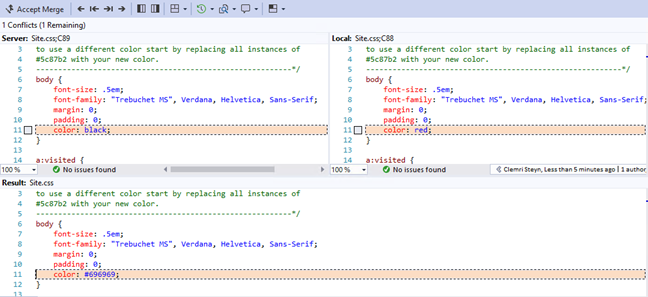
-
Let’s go with server version. Select the checkbox to the left of the body color property choice that uses black (in the left pane).
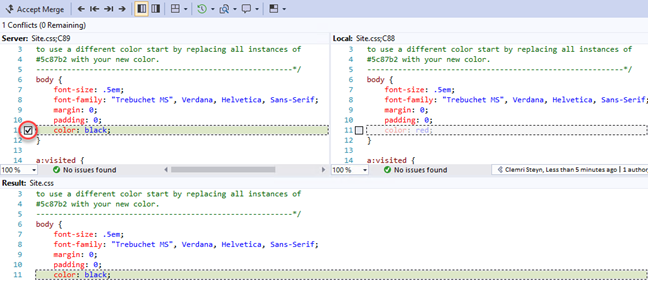
-
In the Merge Toolbar, click the Accept Merge button.

Task 8: Updating a Source Control Branch
-
Open the Source Control Explorer window by selecting the Source Control Explorer tile.

-
The Fabrikam Fiber project contains a main code base (under Main), a development code base (under Dev), as well as release branches (under Releases). Branches are first-class objects that are represented with their own icon in Source Control Explorer.

-
Expand the Releases node and right-click Release1 to select Advanced | Properties from the context menu.

-
The Properties window provides general details like version and description, hierarchical relationship to other branches, and permissions.
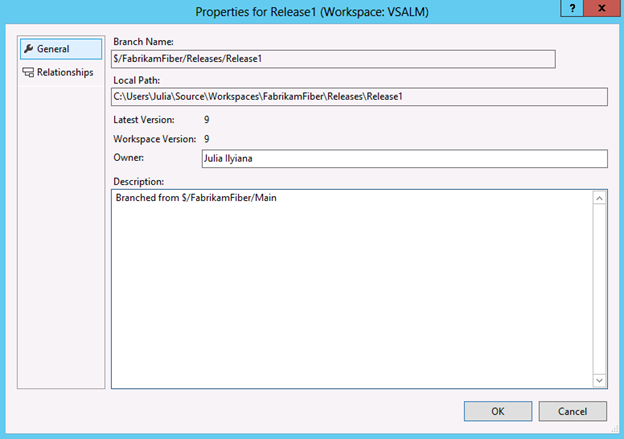
-
Press Esc to return to Source Control Explorer.
-
Expand the Release1 branch node in the Releases folder and locate the FabrikamFiber.CallCenter.sln solution file in the FabrikamFiber.CallCenter folder. Double-click to open it.

-
Press F5 to build and launch the Fabrikam Fiber intranet portal.

-
Imagine a scenario where the Release1 branch represents the code that is currently running on the production web server. Management has decided that the non-functional links under the profile section on the left side of the page should be removed as soon as possible. We have decided to “fast track” this change by making the update directly to the Release1 branch. Later, you will see how we can merge this change back to the Dev branch so that it becomes a part of the changes we’re working on for the next release.

-
Close the Internet Explorer window and return to Visual Studio.
-
Our first task is to update the Release1 branch and deploy the changes to the production web server. From Solution Explorer, open FabrikamFiber.Web\Views\Shared_Profile.cshtml.
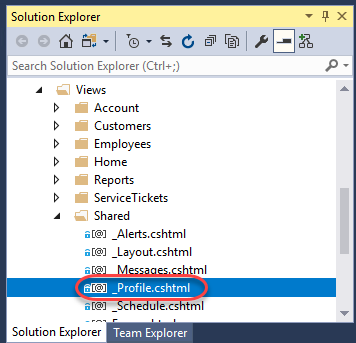
-
Comment out the admin links section as shown below.

-
Press F5 to launch the website and verify that the non-functional links are no longer displayed. For the purposes of this demonstration, assume that at this point we have successfully deployed the updated change to the production server.
-
Close the Internet Explorer window and return to Visual Studio.
-
Open Team Explorer and navigate to Pending Changes.
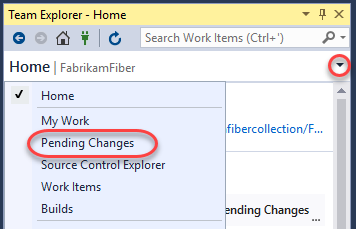
-
Ordinarily you would want to shelve other pending changes before taking on an out-of-band update like this. However, it’s easy to work around when you don’t. Under Included Changes, right-click _Profile.cshtml and select Exclude Unselected to focus on only the change for the Release1 branch.

-
In the Comment field, enter “removed non-functional links from profile”, verify only _Profile.cshtml is changed, and click Check In. Select Yes if prompted to confirm check-in.

-
In the next task, we will merge the changes to the other branches.
Task 9: Branching and Merging Visualization
In this task, you will learn how to visualize and track changesets while merging the changes that you made in the previous exercise.
-
In Source Control Explorer, right-click the Release1 branch and select View History from the context menu. Note that the items in your history may vary from the screenshot below.

-
Right-click the changeset that you just checked in and select Track Changeset from the context menu.

-
In the Select Branches window, select Release1 as the Starting branch. Ensure Check all visible is selected and click Visualize to see the current state of the changeset as it relates to the other branches.

-
This visualization shows us that the changeset has been applied to Release1 but not to Dev. It also makes it clear that in order to merge our changes into Dev we will need to merge with the Main branch first. Note that your changeset numbers may be different from those in the screenshots.

-
To perform the merge of this changeset and the Main branch, drag and drop the green Release1 node onto the Main node. This will load the Source Control Merge Wizard.

-
Ensure that the source branch to merge ends with “Release1” and the target branch ends with “Main”. Select the Next button to continue.

-
The next screen of the merge wizard specifies the version to merge. By default, you should see the changeset that you just checked in. Select the Finish button to perform the merge.

-
After the merge is complete, open Team Explorer and navigate to Pending Changes.

-
Note that _Profile.cshtml changed status for the Main code branch and is now “merge, edit”. The merge process is complete, but we still need to check in the changes.

-
Add a Comment of “Merging fast-tracked changes from Release to Main” and then click Check In to finalize the merge. Select Yes if asked to confirm the check-in.

-
In the Tracking Changeset window, select the Rerun button to generate an updated view.

-
Click Visualize again when the Select Branches window appears to see an updated visualization.

-
Next, merge the changeset from the Main branch with the Dev branch in the same manner as before by dragging and dropping to load the Source Control Merge Wizard.
-
Select Next followed by Finish to perform the merge process.
-
In the Pending Changes window, enter a Comment of “Merged fast-tracked changes from Main to Dev”.
-
Select the Check In button to finalize the merge with the Dev branch. Select Yes if asked to confirm the check-in.
-
In the Tracking Changeset window, click Rerun to see the updated view.

-
Another useful view is the Timeline Tracking view. Select the Timeline Tracking button to the left of the Hierarchy Tracking button to switch to this view. This shows the order in which the original changeset was merged with the other branches.


-
In Solution Explorer, navigate to and right-click _Profile.cshtml to select Source Control | Annotate from the context menu.
-
Scroll to the bottom of the annotated _Profile.cshtml file and locate the HTML that you previously commented out.
-
In the annotation column on the left-hand side, mouse over the recent changeset (it should show the date of the guest virtual machine). Note that the changeset path and comment refer to the Production branch where the original change was made.
